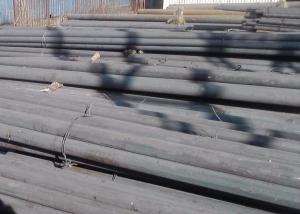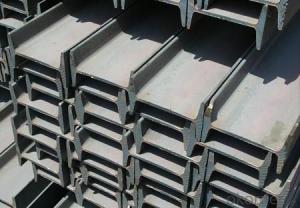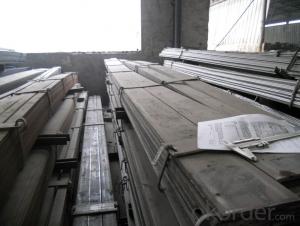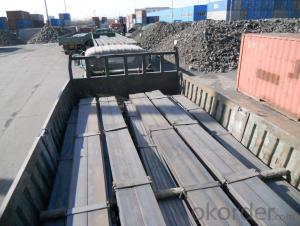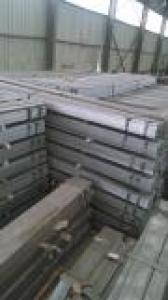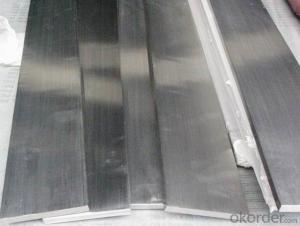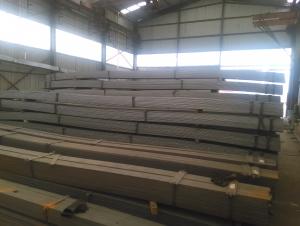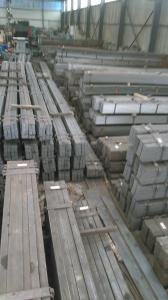Steel Flat Bar Grade JIS SS400 B Added
- Loading Port:
- Tianjin
- Payment Terms:
- TT or LC
- Min Order Qty:
- 50 m.t.
- Supply Capability:
- 10000T m.t./month
OKorder Service Pledge
OKorder Financial Service
You Might Also Like
Product Description:
OKorder is offering Steel Flat Bar Grade JIS SS400 B Added at great prices with worldwide shipping. Our supplier is a world-class manufacturer of steel, with our products utilized the world over. OKorder annually supplies products to African, South American and Asian markets. We provide quotations within 24 hours of receiving an inquiry and guarantee competitive prices.
Product Applications:
Steel Flat Bar Grade JIS SS400 B Added are ideal for structural applications and are widely used in the construction of buildings and bridges, and the manufacturing, petrochemical, and transportation industries.
Product Advantages:
OKorder's Steel Flat Bar Grade JIS SS400 B Added are durable, strong, and wide variety of sizes.
Main Product Features:
· Premium quality
· Prompt delivery & seaworthy packing (30 days after receiving deposit)
· Can be recycled and reused
· Mill test certification
· Professional Service
· Competitive pricing
Product Specifications:
Manufacture: slited
Slitting precision (width) : 0.5 mm or less
Raw material: Q235B, Q345B, Q235-1 b
crosscutting precision (length) : 2 mm or less
Processing: the thickness of 2.0-16 mm;
Shear length: 2000 mm above
Wide degree: 15-1250 - mm;
Leveling precision: 1-2 MM square
Packaging: Export packing, nude packing, bundled
FAQ:
Q1: How many tons of steel products could be loaded in containers?
A1: Usually the steel products are delivered by bulk vessel because of the large quantity and the freight. However, there are no bulk vessel enter some seaports so that we have to deliver the cargo by containers. The 6m steel product can be loaded in 20FT container, but the quantity is changed according to the size, usually from 18tons to 25tons.
Q2: what is the difference between actual weight and theoretical weight?
A2: All the section steel has two weights: actual weight and theoretical weight. Actual weight is the weighing out when the product delivered from the mill. Theoretical weight is calculated by pieces. The invoice can be based on each of them as your request.
Q3: How soon can we receive the product after purchase?
A3: Within three days of placing an order, we will arrange production. The normal sizes with the normal grade can be produced within one month. The specific shipping date is dependent upon international and government factors, the delivery to international main port about 45-60days.
Images:

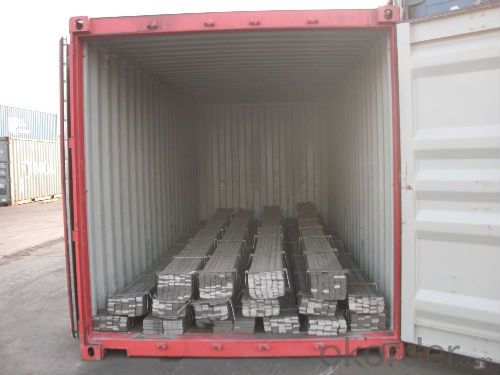
- Q:Can steel flat bars be easily bent or shaped?
- Steel flat bars can be easily bent or shaped depending on their thickness and the type of steel used. Thinner flat bars are generally more malleable and can be bent or shaped with relative ease. However, thicker and harder steel flat bars may require more force and specialized tools to bend or shape. It is important to note that the bending or shaping process may also depend on the specific requirements and desired outcome. Professional metalworkers or fabricators often use techniques such as heat treatment or cold working to achieve the desired shape or bend in steel flat bars.
- Q:Are steel flat bars available in different colors or finishes?
- No, steel flat bars are typically not available in different colors or finishes. Steel is often left unfinished or coated with a protective layer to prevent rust or corrosion.
- Q:What are the different methods of surface engraving for steel flat bars?
- Steel flat bars can be surface engraved using various methods. These methods are as follows: 1. Laser engraving: This technique utilizes a powerful laser beam to eliminate material from the surface of the steel flat bar. It is perfect for intricate designs and logos due to its precise and detailed engravings. 2. Mechanical engraving: This method involves physically removing material from the steel flat bar's surface using a cutting tool or bit. It is commonly used for basic designs and straightforward text. 3. Chemical etching: By applying a chemical solution to the steel flat bar's surface, chemical etching selectively removes the material to create the desired design or text. This method is ideal for producing high-quality and detailed engravings. 4. Electrochemical etching: Electrochemical etching uses an electric current to remove material from the steel flat bar's surface, resulting in the desired design or text. It is commonly employed for marking or labeling purposes and offers clear and permanent engravings. 5. Sandblasting: This technique involves propelling abrasive materials, such as sand or glass beads, onto the steel flat bar's surface using high-pressure air or steam. It creates a textured or frosted effect and can be used for engraving simple designs or text. Each of these methods possesses its own advantages and is suitable for different applications. The choice of engraving method depends on factors like the desired design, level of detail, durability requirements, and cost considerations.
- Q:How is steel flat bar manufactured?
- The production of steel flat bar requires the use of raw materials, machinery, and skilled labor. The process begins by selecting high-quality steel, typically in the form of billets or slabs. These steel pieces are then heated in a furnace to increase their malleability. Once the steel has reached the desired temperature, it is passed through a series of rollers in a process known as hot rolling. Massive rotating rollers are used to shape the steel into a flat bar. The rollers apply high pressure to gradually reduce the thickness of the steel and increase its length. This process is repeated until the steel reaches the desired dimensions. After hot rolling, the steel flat bar may be subjected to pickling to eliminate any scale or impurities present on its surface. Pickling involves immersing the steel in an acid bath that chemically reacts with and removes the impurities. This step guarantees a clean and smooth surface finish. Once the desired surface finish is achieved, additional processes such as cold rolling or cold drawing may be employed to further refine the dimensions and improve the surface quality of the steel. Cold rolling entails passing the steel through rollers at room temperature, while cold drawing involves pulling the steel through a die to reduce its thickness and increase its length. Finally, the steel flat bar may undergo various finishing processes, including cutting, machining, or surface treatments, depending on its intended use. These processes ensure that the steel flat bar is cut to the required length and that its edges are smooth and free from any flaws. In summary, the manufacturing of steel flat bar involves a combination of heating, rolling, pickling, and finishing processes to transform raw steel into a versatile and widely used construction material.
- Q:Why is it better to use round steel than that of flat steel in lightning protection?
- Presumably, it's a discussion, not an answer.At the same length and with the same cross section,(1) the contact area between flat steel and earth is slightly larger.(2) flat steel is easier to bend than round steel, so it is more convenient to construct.(3) flat steel is easier to connect with bolt by connecting bolt.
- Q:What is the typical shear strength of steel flat bars?
- Depending on the specific grade and thickness of the material, the shear strength of steel flat bars can vary. Typically, steel flat bars exhibit shear strengths ranging from 40,000 to 60,000 pounds per square inch (psi). It is crucial to consider that these values may differ due to factors like heat treatment, composition, and manufacturing processes employed in the production of the steel flat bar.
- Q:How can I prevent rusting on steel flat bars?
- To avoid rust on steel flat bars, there are several actions you can take. Firstly, it is important to thoroughly clean the flat bars and remove any dirt, debris, or moisture before storing or using them. This can be achieved by wiping them with a dry cloth or, if necessary, using a mild soap and water solution. Next, it is advised to apply a protective coating or finish to the steel flat bars. There are various alternatives available, such as painting, powder coating, or using a rust-resistant primer. These coatings create a barrier between the steel and the surrounding environment, preventing moisture and oxygen from reaching the metal surface and causing rust. Moreover, it is worth considering the use of corrosion-resistant materials when constructing steel flat bars. Stainless steel, for example, contains chromium which forms a protective layer on the surface, making it highly resistant to rust. Another option is galvanized steel, which is coated with a layer of zinc to provide excellent corrosion resistance. Proper storage is also crucial in preventing rust. Ensure that the steel flat bars are kept in a dry and well-ventilated area, away from any moisture or humidity. If storing them outdoors, make sure they are adequately covered and protected from rain and other elements. Regular maintenance is essential as well. Periodically inspect the flat bars for any signs of rust or damage. If any rust spots are detected, promptly remove them using a wire brush or sandpaper, and apply a touch-up coating to prevent further corrosion. By implementing these preventive measures, you can significantly reduce the likelihood of rusting on steel flat bars and extend their lifespan.
- Q:Are steel flat bars prone to corrosion?
- Corrosion is a common issue for steel flat bars. Being primarily composed of iron, steel can undergo a reaction with moisture or specific chemicals, resulting in the formation of iron oxide, commonly known as rust. This chemical process is referred to as corrosion. Although steel is generally more resistant to corrosion in comparison to metals like aluminum, it is not entirely impervious. The rate at which corrosion occurs can be influenced by various factors, including the quality of the steel, environmental conditions, and the presence of corrosive agents. To reduce the risk of corrosion, steel flat bars can be coated with galvanization or paint, or manufactured using corrosion-resistant alloys like stainless steel. Consistent maintenance and proper handling practices are also essential in preventing and minimizing corrosion.
- Q:Can steel flat bars be used in the construction of pipelines?
- Yes, steel flat bars can be used in the construction of pipelines. Steel flat bars are commonly used in various industries, including construction, due to their strength, durability, and versatility. In pipeline construction, steel flat bars are often used as supports, brackets, or reinforcement in the pipeline structure. They can also be used as a base for pipe hangers or to provide additional strength and stability to the overall pipeline system. Additionally, steel flat bars can be welded or bolted together to create custom fittings or connections in the pipeline. Overall, steel flat bars are a reliable and cost-effective choice for use in pipeline construction.
- Q:How do you determine the creep resistance of a steel flat bar?
- The creep resistance of a steel flat bar can be determined by subjecting the material to a constant load or stress for an extended period of time at elevated temperatures. This involves conducting creep tests, where the flat bar is placed in a specialized testing apparatus and exposed to specific temperature and stress conditions. The deformation or strain that occurs over time is then measured, and the creep resistance is determined by analyzing the rate of deformation and the ability of the steel to withstand creep under the given conditions.
1. Manufacturer Overview |
|
|---|---|
| Location | |
| Year Established | |
| Annual Output Value | |
| Main Markets | |
| Company Certifications | |
2. Manufacturer Certificates |
|
|---|---|
| a) Certification Name | |
| Range | |
| Reference | |
| Validity Period | |
3. Manufacturer Capability |
|
|---|---|
| a)Trade Capacity | |
| Nearest Port | |
| Export Percentage | |
| No.of Employees in Trade Department | |
| Language Spoken: | |
| b)Factory Information | |
| Factory Size: | |
| No. of Production Lines | |
| Contract Manufacturing | |
| Product Price Range | |
Send your message to us
Steel Flat Bar Grade JIS SS400 B Added
- Loading Port:
- Tianjin
- Payment Terms:
- TT or LC
- Min Order Qty:
- 50 m.t.
- Supply Capability:
- 10000T m.t./month
OKorder Service Pledge
OKorder Financial Service
Similar products
New products
Hot products
Hot Searches
Related keywords








